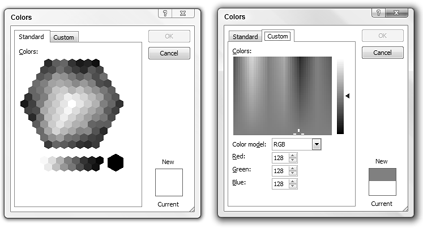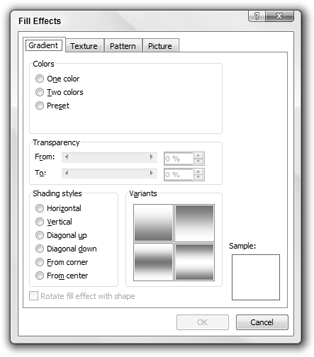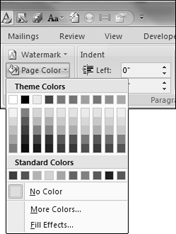IN THIS CHAPTER
Page background
Colored backgrounds
Patterned background
Textured backgrounds
Watermarks
If you're a "white pages" person, you might not care much about backgrounds. Even if you like the idea of sprucing up the page a little, you might not be keen on the extra ink or toner it takes to nurture those sprucing instincts. Thanks to the web, PDF, XPS, and other potentially paperless approaches to sharing the written word, however, ink and toner need not be considerations anymore. Much of what is published will never see a piece of paper.
Or, perhaps you're one of the millions who, while liking pretty backdrops as much as the next person, don't really want text to be any harder to read than it is already. Indeed, just about any time you venture out onto the information superhighway, you are blinded by headlights shining on presentations that put the sin into presintation. You know—those oh-too-cute web pages that are clever in concept but flunk the legibility test.
In this chapter, we're going to take a look at backgrounds: how to use them, how not to use them, when to use them, and when not to use them. After all, this is a Bible, so you have to expect at least a little bit of preaching. Let's get started.
There are numerous different types of page backgrounds, used to add color, personality, or information to a document. They include the following:
Background colors and patterns—Used mostly for decorative purposes to add color to presentations
Background pictures—Used for decorative purposes or to add some kind of subliminal message
Decorative watermarks—Used to "stamp" documents with a particular trademark or symbol
Informative watermarks—Used to add things like CONFIDENTIAL, DRAFT, SAMPLE, or DO NOT COPY to the background of every page of a document to prevent printed versions from being misused or misrepresented
Page borders—Used mostly for aesthetic purposes to give some documents a more polished look
Background colors, patterns, images, and messages can be used both on printed and nonprinted (designed to be viewed on a computer screen) documents. For printed documents, more care needs to be taken so that you don't waste ink or create biohazards. A practical consideration with many inkjet printers is that ink doesn't dry immediately and paper doesn't necessarily dry flat. A piece of paper saturated with ink is messy and will need to be separated from other paper to dry. It's not unusual for ink to bleed through to the back—an added problem especially when doing duplex printing. You can find special papers designed to withstand such printing, but they are more expensive than regular paper, adding to the cost of printing.
As a result, when designing documents to be printed, you should avoid creating documents that will result in saturated paper. Even when using toner instead of ink, saturation and other bad things can occur, causing smears, buckling, and bulging paper.
Word knows all this, and by default is set not to include background colors and images when you print. To instruct Word to include background colors and images when printing, choose Office
Tip
Notice the option to "Print drawings created in Word." Ordinarily, you might think in terms of shapes and perhaps SmartArt. However, "drawings created in Word" includes WordArt, SmartArt, shapes, and even pictures if they have been modified for printing as a page background, or watermark. To fully enable printing of all background colors, images, and watermarks, enable both of these options. By the same token, to prevent printing background colors, images, and watermarks, remove the checkmarks to disable both of these options.
For documents designed to be read on the computer screen, ink and paper aren't a concern. These include documents that "live" on the Internet or on an intranet as various flavors of HTML files, as PDF or XPS files, or even as regular Word documents.

Figure 28.1. To enable background colors and images to print, enable "Print background colors and images," which is turned off by default. "Print drawings created in Word" is enabled by default.
What is a concern with onscreen documents, however, is legibility. Art is important, but so is being able to read what's written. If the color combinations are so bad that they induce eyestrain, or if text gets utterly lost in a background pattern or image, then your document won't live up to its potential to communicate via the written word. If you're deliberately trying to obscure the message, on the other hand—you won't have to try terribly hard.
It's important to understand the difference between page background and watermarks. Page background is a document-wide setting. You set the page background using the Page Color tool in the Page Background section of the Page Layout ribbon. You can have only one page background setting in any given document, and the identical page background will appear on every page.
A watermark, on the other hand, is a section formatting setting. While it's common to have only a single watermark in any given document and to have the identical watermark on all pages, it is by no means required. Sufficient diligence and patience, blended with exuberance and obsession, could yield a 200-page document with a different watermark on every single page. Why would you do this? To prove that diligence and patience aren't a barrier to exuberance and obsession, of course!
It's important to know that one is a document-wide setting and the other is a section formatting attribute because it can keep you from beating your head against the wall trying to have a different background for each page using the Page Color tool. If you want a different background for each page, you can do it, but not using the Page Color tool.
Word 2007 provides a variety of colors, patterns, gradients, and textures for use as a document background. In addition, you can use pictures in any of the graphics formats supported. Formats supported include the graphics filters that come with Office 2007, those installed for earlier versions of Office, as well as some installed with other Windows programs.
The backgrounds discussed in this section are applied to the entire document, not to specific document sections. Therefore, whatever you use should be coordinated with text and other graphics in all parts of the document.
To change the background color (which by default is set to No Color), click Page Color in the Page Layout ribbon. This displays the palette shown in Figure 28.2. If you want your background to vary with changes in theme, then pick one of the theme colors shown. If you don't want your background to change when you change themes, then choose from Standard Colors or click More Colors. To remove background color at any time, return to Page Color in the Page Layout ribbon and choose No Color.
If the Standard Colors don't provide the color you're looking for, click More Colors, to display the Standard or Custom colors shown in Figure 28.3. Standard enables you to choose from among 144 colors and shades of gray between white and black. For both Standard and Custom, the New and Current indicator shows the current background and the background you'll get by clicking OK.

Figure 28.3. Custom provides access to up to 16,777,216 colors (that's 2563 if you're interested). To set a custom color, click in the Colors area and drag. When you get close, you can use the side tool to choose different shades of the selected color. Drag the triangle up or down to select the shade you want.
Note
If you're trying to match an exact color, the Custom tab enables you to choose between two schemes: RGB (Red, Green, Blue) and HSL (Hue, Saturation, Luminance). Enter the numbers corresponding to the color you want and click OK.
There are two general approaches to applying color backgrounds. The first approach is to apply colors that use theme information, in which case colors and other elements will change when you apply different themes, as discussed in Chapter 31, "Templates and Themes." The second approach is to ignore themes.
This might sound harsh, but themes are there for your convenience. If you use theme elements for different aspects of your documents, that's fine. If you consider themes irrelevant, that's fine, too. If you choose to ignore themes, however, then make sure you really ignore themes.
For example, in the default Office theme, Text 2 is a shade of blue with RGB values of 31, 73, and 125. If you like that color for a background, but don't want theme settings to mess with it later, don't use Page Color
To set the color in a way that is immune to theme changes, first select the desired color using the theme color you want. Then, click Page Color
The result is that you've set a custom color that happens to be the same as one of the theme colors, but because you used the Custom color dialog box to do it, it is now not connected with any particular theme, and will stay put when and if you change overall theme or theme colors.
Gradient or image gradient is a term that refers to the gradual blending of colors, not unlike those shown in the Custom tab of the Colors dialog box (refer to Figure 28.3). To set a gradient page background, in the Page Layout ribbon, choose Page Color

Figure 28.4. A gradient document background can be a blend of one or two colors, or a choice of 24 preset combinations.
If the base color(s) of the displayed gradients aren't to your liking, click to enable One color, Two colors, or Preset. Options change depending on what you select. Under Shading styles, you can choose from six variants.
Note
Notice that Transparency is grayed out as unavailable. That's because it doesn't work for page backgrounds, as the background is by definition at the back. There's nothing behind it, so transparency is irrelevant. It is enabled when setting the fill for shapes, for example, which can be in any graphic layer of a document, and for which transparency is therefore quite relevant.
Texture refers to a variety of different backgrounds—everything from wood, to different fabrics, to marble. Word offers 24 built-in textures plus the facility to insert your own from existing graphics/picture files.
To use a texture as your page background, in the Page Layout ribbon, choose Page Color

Figure 28.5. You can choose from among 24 built-in textures, or click Other Texture to use a file of your own to create texture.
Note
When you choose a picture file to use for a texture, depending on the size and resolution, Word sometimes tiles the image. Tiling means that if the image isn't large enough to fill the space, multiple copies are used. For small graphics, you might end up with hundreds of that image as your background. For tiling to work, the edges need to be designed so that they blend seamlessly (unless you want it to look tiled). Otherwise, the image has to be large enough that tiling isn't necessary.
Word provides 48 preset patterns you can use for the background. To use a pattern for your page background, choose Page Color
A watermark is a special faded graphic that appears underneath the document text, usually on every page of a document. It might contain a picture or text, such as the huge word CONFIDENTIAL.
To insert a prefabricated text watermark, choose Insert
As shown in Figure 28.7, the watermark actually is a WordArt object. To mold this into exactly what you want, see Chapter 22, "WordArt."
If the Building Blocks Gallery doesn't have a preset text watermark that suits your needs, you can insert and then edit an existing one using the WordArt tools shown in Chapter 22, or you can use the Watermark tool.
To insert a text Watermark using the Watermark tool, in the Page Layout Ribbon, choose Watermark

Figure 28.8. If you have other languages installed, Word can insert a variety of preset text watermarks, or type your own message.
Choose the desired font, color, layout, and whether you want the watermark to be semi-transparent or solid (the unwritten alternative). For Size, you're generally best off leaving it set to Auto, as that will choose the largest possible font that works for the chosen text and the current paper/margin sizes.
While the Printed Watermark dialog box doesn't provide live preview, it does let you click Apply without closing the dialog box so you can get an idea of what the watermark will look like. If necessary, make changes until you're satisfied, and click Apply again. Click OK or Close when you're done.
To use a picture for your watermark, click to select Picture Watermark in the Printed Watermark dialog box. Click on Select Picture, navigate to the desired folder, click on the picture you want to use, and then click Insert. Back in the Printed Watermark dialog box, set the desired scale and choose Washout, unless your picture is already suitably light. As before, you can click Apply to see if the picture appears as you want, changing pictures or options until you're satisfied. When you're ready, choose OK or Close.
In years past, removing watermarks was quite an ordeal. You had to edit the header or footer where it was stored and delete it at its source. Word 2007 has a new search-and-destroy system for zapping watermarks. When you want to remove a watermark, in the Page Layout ribbon, click Watermark
If you try to remove a watermark and it doesn't go away, then it's not a watermark. It's probably a page background instead. To remove a page background—even if it's a picture, gradient, or pattern—in the Page Layout ribbon, choose Page Color
In this chapter, you've learned how to create a variety of page backgrounds for your documents. You've also seen that you need to be careful to maintain a balance between art and legibility. You should now be able to do the following:
Create colored backgrounds, and control whether or not Word prints them
Distinguish between page backgrounds and watermarks
Match a page background color exactly by using RGB or HSL settings
Quickly remove a watermark or a page background



